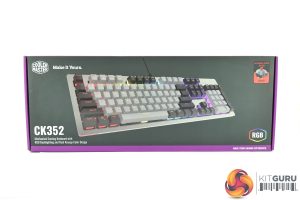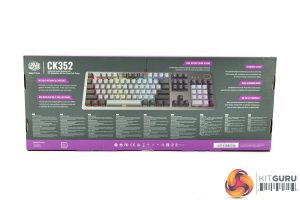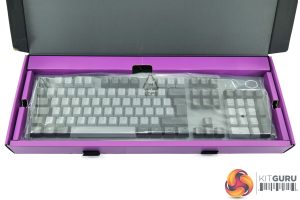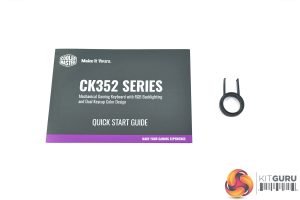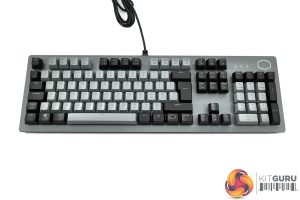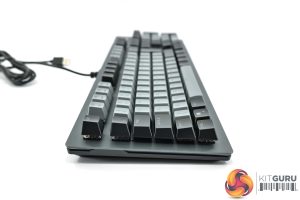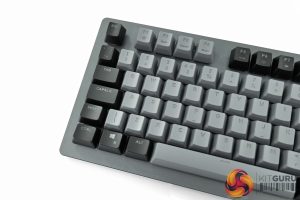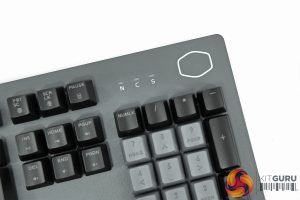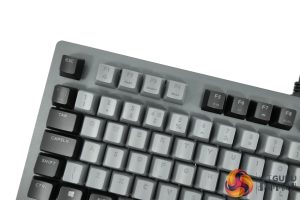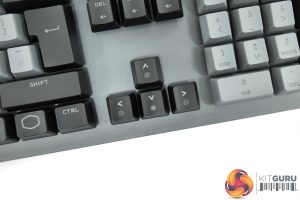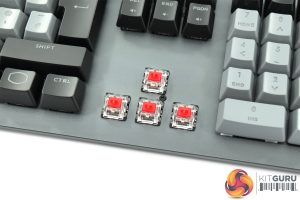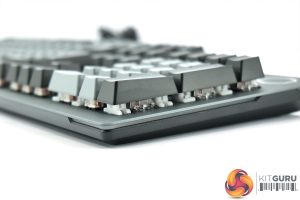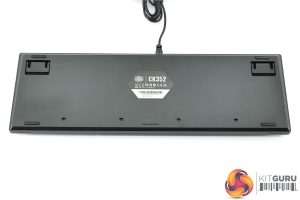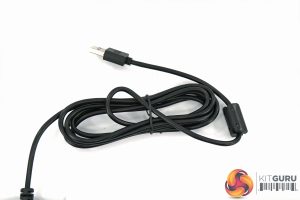Shipping in a dark box, a large image of the Cooler Master CK352 is immediately visible on the front, with Cooler Master also keen to point out this board is indeed using mechanical switches.
On the back, we find multi-lingual text highlighting various key features and specifications of the board.
Opening up the box reveals the keyboard itself, sitting in a thin plastic covering. The only included accessories consist of a quick start guide and a keycap puller.
As for the board itself then, I have to say it looks very good from a purely visual perspective. Usually we'd expect a cheaper keyboard to have a clunky or basic appearance, and while at £70 the CK352 isn't a bargain-basement offering, I'd say it is still up there with the more premium-looking keyboards we have reviewed.
A large part of that comes from the sandblasted aluminium top-plate, which not only adds more rigidity to the build, but also looks a lot better than an all-plastic construction. On that note, I would also say that the colour of the metal plate itself is a fair bit lighter than what is shown in Cooler Master's stock photos of the board. In those images, it looks like a very dark grey, but in good light (as we can see here), it is more of a light/mid grey.
One other good-looking part of the design is the use of dual-tone keycaps. This is pretty common in the world of custom mechanical keyboards, but most off-the-shelf boards from big gaming companies stick with single-colour keycaps. Cooler Master has bucked that trend and gone with grey caps on the letters and numbers, but black caps on the modifier keys. That colour scheme, coupled with the grey aluminium top-plate, gives an overall appearance that is not dissimilar to the Drop CTRL.
Obviously this is a full-size board too, but right now Cooler Master does not offer a TKL (tenkeyless, or 80%) option. The only area with any branding on the keyboard itself is a clean white Cooler Master hexagonal logo in the top right corner.
We've already mentioned how the CK352 does not offer any software control, but that's not to say you can't adjust things like the RGB lighting or control media playback – these are all just secondary functions dotted about the board. We take a closer look at the controls themselves on the next page, but you will notice a load of secondary legends printed on the F-keys, on the arrows keys, the INS/HOME/PGUP keys and so on.
The keycaps themselves are ABS material, but interestingly the exact process varies depending which layout you buy – for those in some Asian regions and the US, Cooler Master uses double-shot caps with laser engraved legends, but for our UK sample, the ABS plastic is painted and then laser engraved, but with a UV coating.
PBT is my preferred material, but is is understandable that Cooler Master wants to keep cost down – the ABS caps will just become shiny over time. Cooler Master uses an OEM keycap profile.
Underneath those caps, we get a look at the mechanical switches. These are LC-branded switched, in the Red variety – meaning linear and non-clicky, as you would expect. I'd never heard of LC before and a little bit of digging online suggests they are a fairly budget switch choice, though Cooler Master still claims a 50m click lifespan. We talk more about the feel and performance on the next page.
It is worth noting, however, that in the UK it is only possible to get the CK352 with these Red switches. Cooler Master lists Brown and Blues as options for the CK352, but those are region-specific and will not be available in the UK.
Elsewhere, each corner of the keyboard is home to a small LED strip that bends from the bottom edge, round to the side of the frame. This is in addition to the per-key RGB lighting found on the key switches themselves. We take a look at the RGB lighting itself on the next page
The underside of the board is almost entirely plain. It's made of black plastic, with a sticker in the middle. Two flip-out feet are also visible in the top corner, while five small rubber anti-slip pads are also positioned around the edges.
Lastly, the cable measures 1.8m, is made of rubber and is non-detachable. It terminates with a standard USB Type-A connector.
Be sure to check out our sponsors store EKWB here
 KitGuru KitGuru.net – Tech News | Hardware News | Hardware Reviews | IOS | Mobile | Gaming | Graphics Cards
KitGuru KitGuru.net – Tech News | Hardware News | Hardware Reviews | IOS | Mobile | Gaming | Graphics Cards


